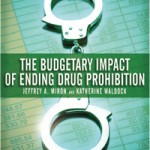Copyright © 2010 by the Cato Institute.
White Paper
September 27, 2010.
The Budgetary Impact of Ending Drug Prohibition
by Katherine Waldock and Jeffrey A. Miron
Jeffrey A. Miron is a senior lecturer in economics at Harvard University and a senior fellow at the Cato Institute.
Professor Miron earned his Ph.D. from the Massachusetts Institute of Technology and chaired the economics department
at Boston University prior to joining the Harvard faculty. Katherine Waldock is a doctoral candidate at the
Stern School of Business at New York University.
State and federal governments in the United States face massive looming fiscal deficits. One
policy change that can reduce deficits is ending the drug war. Legalization means reduced expenditure
on enforcement and an increase in tax revenue from legalized sales.
This report estimates that legalizing drugs would save roughly $41.3 billion per year in government
expenditure on enforcement of prohibition. Of these savings, $25.7 billion would accrue to state and
local governments, while $15.6 billion would accrue to the federal government.
Approximately $8.7 billion of the savings would result from legalization of marijuana and $32.6
billion from legalization of other drugs.
The report also estimates that drug legalization would yield tax revenue of $46.7 billion annually,
assuming legal drugs were taxed at rates comparable to those on alcohol and tobacco.
Approximately $8.7 billion of this revenue would result from legalization of marijuana and $38.0
billion from legalization of other drugs.
Pdf. file: http://www.cato.org/pubs/wtpapers/DrugProhibitionWP.pdf
![The Budgetary Impact of Ending Drug Prohibition Copyright © 2010 by the Cato Institute. White Paper September 27, 2010. The Budgetary Impact of Ending Drug Prohibition by Katherine Waldock and Jeffrey A. Miron Jeffrey A. Miron is […]](https://brugerforeningen.dk/wp-content/uploads/2013/04/031.jpg)
